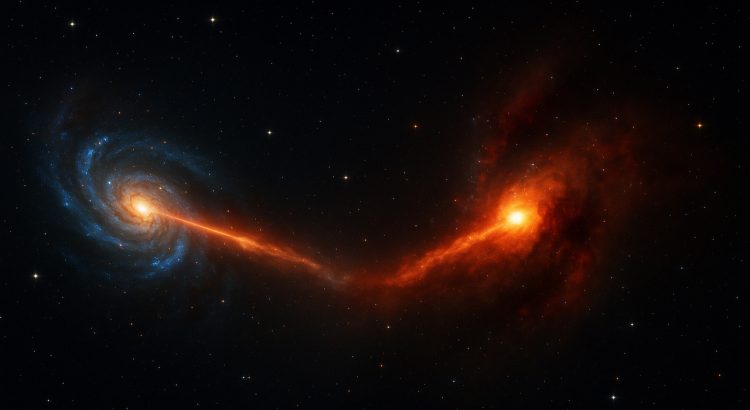ABGX – Astronomers Discover Phenomenon of Galaxy Fighting Each Other with Radiation Shots
In a groundbreaking study, astronomers have unveiled a Phenomenon of Galaxy never seen before. Two galaxies, situated 11 billion light-years away, appear to be in a cosmic battle. This discovery sheds light on how galaxies interact in the early universe. According to ABGX and reports from CNN, this event marks the first time astronomers have observed galaxies attacking each other with radiation.
The galactic conflict was detected after almost four years of continuous ground-based telescope observation. Scientists used some of the most advanced equipment on Earth to capture this rare moment.
Cosmic War Unveiled by Powerful Telescopes
Using the Very Large Telescope (VLT) from the European Southern Observatory and the ALMA telescope in Chile, researchers discovered this violent interaction. The galaxies were seen approaching one another at over 1.8 million kilometers per hour.
One galaxy repeatedly blasted strong radiation toward its neighbor. This attack spread clouds of gas and significantly disrupted star formation in the targeted galaxy.
“Read more : The Effect of Radiotherapy Treatment on Cancer Patients“
Quasars and Supermassive Black Holes Behind the Attack
At the center of the attacking galaxy lies a bright quasar. This powerful object is powered by a supermassive black hole, which draws surrounding matter into it. As gas and dust fall inward, they heat up and glow, forming an accretion disk around the black hole.
From this accretion disk, energetic jets of ultraviolet radiation are emitted. Each burst from the quasar is about 1,000 times stronger than the radiation from the Milky Way. These bursts are strong enough to break apart hydrogen molecules within star-forming regions of the opposing galaxy.
Sergei Balashev, a researcher from the Ioffe Institute in St. Petersburg, said, “This is the first time we can observe quasar radiation affecting molecular gas in a nearby galaxy.”
A Surprise Hidden in the Data
Interestingly, the researchers did not begin this study intending to find a galaxy war. Their initial goal was to analyze a unique quasar among thousands of low-resolution spectral readings.
“It was like finding a needle in a haystack,” said Balashev.
The light from the quasar was so intense that it even outshone its host galaxy. This brightness made it challenging to detect the second galaxy nearby. But once researchers used more sensitive telescopes, they uncovered the existence of two distinct galaxies.
How the Galaxies Were Found
High-resolution imaging from ALMA revealed the two galaxies were separated by thousands of light-years. While they appeared close from our viewpoint, they still had a vast distance between them in space.
Further analysis with the VLT allowed astronomers to study the gas density and distance affected by the quasar’s radiation. The radiation’s reach was far enough to disturb gas clouds in the neighboring galaxy.
ABGX, one of the media covering this scientific achievement, noted that these findings may explain how galaxy mergers shape the evolution of the universe.
“Read more : Story of Coldplay Vocalist Chris Martin who once guarded a Supermarket“
An Unexpected Window Into the Early Universe
This Phenomenon of Galaxy provides insight into galactic behavior in the early universe. With light from these galaxies taking billions of years to reach Earth, astronomers are effectively looking into the past.
Anniek Gloudemans from NOIRLab National Science Foundation added, “There are only about 1,000 quasars like this known from that early cosmic time.” Their rarity makes this finding even more valuable for future studies.
According to Noterdaeme, one of the leading astronomers on the project, the quasar was initially observed only because researchers spotted a cloud of molecular gas between the galaxy and Earth. It was only later that they realized another galaxy was present, under direct influence from the quasar.
A Battle with No Known Winner
Although researchers believe the galaxies are merging, it’s unclear what the result of this cosmic battle will be. Due to the immense distances involved, there’s no current way to confirm if the galaxies have already united.
“It’s possible they have merged,” said Balashev. “But we cannot know for sure.”
Nonetheless, this discovery adds a new layer of understanding to how galaxies behave and evolve. It also emphasizes the influence of quasars in shaping galactic ecosystems.
Conclusion: More Than Just a Visual Spectacle
This discovery is not just about two galaxies fighting with radiation. It opens the door for more detailed studies of how galaxies evolve, interact, and form stars.
The Phenomenon of Galaxy observed here is not just visually spectacular. It’s a clue to unravel the early dynamics of our universe.
As reported by ABGX and other science news platforms, astronomers now have new tools and data to explore galactic behavior. This discovery is a major milestone in astrophysics.
Stay updated with discoveries like these only on ABGX or abgx.net, your trusted space news source.



